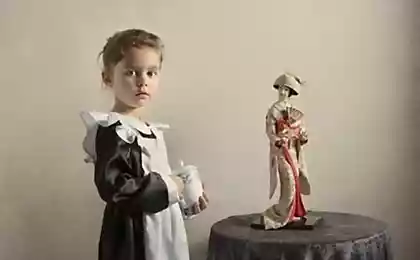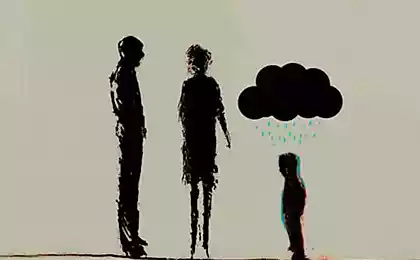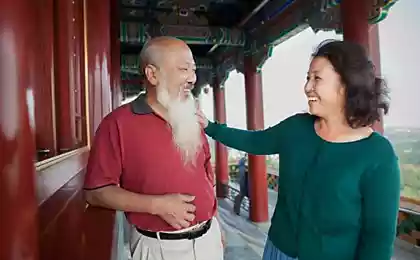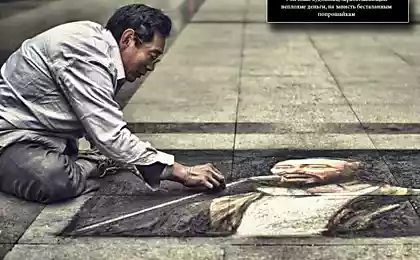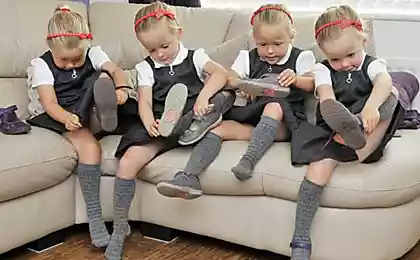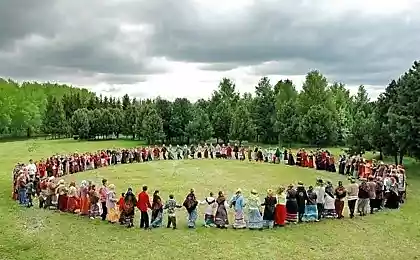696
10 things about the Chinese school that I learned, having worked as a teacher in China

To be Chinese is not easy. When you have these more than half a billion in a country without social security, it is necessary to work strongly to find a place under the sun. But Chinese kids are ready ― they have heavy work begins with the first class.
At the time, I worked as an English teacher in four Chinese schools (and a coach at the school kung-fu). It is therefore very interesting to compare Russian education and the schools of China.

Children in school uniforms ―tracksuits ―in the session on Earth Day, Liaocheng, April 2016.
In many schools of China there is no heating, so in winter the teachers and pupils do not remove clothing. Central heating is only to the North of the country. In the centre and South of China building designed for warm climate. This means that in winter, when temperatures can drop to zero, and sometimes below, the only means of heating are air conditioned. School uniform ― sports outfit: wide trousers and a jacket. Fit is almost the same everywhere, differ only in the color of the suit and the school logo on the chest. All the schools are limited to large iron gates that are always kept closed, opening only to the students could leave. In Chinese schools every day doing exercises (and not one) and conduct a total line. Morning school starts with charging, then the bar on which provide basic news and raise the flag ― the school or state. After the third lesson all kids do exercises for the eyes. The soothing music and the voice of the speaker in the recording, students press on a special point. In addition to the morning exercises, there charge a day ― about two o'clock, when, under the same relentless speaker, the students in unison, spilling into the corridor (if there is insufficient space in the classroom), begin to raise his hands to the sides and up and jump.

Chinese students from the city of Jinan do exercises on the roof.
Big change, she is the lunch break usually lasts an hour. During this time, children have time to go to the dining room (if the dining room at school no, they bring the food in special trays-boxes), lunch, and more to run, to stretch your legs, shout and fool around. Teachers in all the schools where they serve lunch for free. And the food, I must say, very well. Lunch traditionally consists of one meat and two vegetable dishes, rice and soup. In expensive schools give more fruit and yogurt. In China love to eat, and even school traditions are observed. After the lunch break in some Junior schools are given five minutes "to sleep". By the way, a couple of times, my students fell asleep in the middle of class, and the poor girl had to Wake up with a bleeding heart.

Option is modest by Chinese standards, school lunch: eggs with tomatoes, tofu, cauliflower, pepper, rice.
The teachers attitude is very respectful. They are called by the name with the prefix "master", for example, the teacher Zhang or teacher Xiang. Or just "teacher." In one school, students ― no matter my or not meeting me and bowed. In many schools in order of physical punishment. The teacher can hit the pupil by the hand or pointer for some offense. The farther from the big cities and the easier the school, the more widespread it is. My Chinese friend told me that they gave the school some time to learn English words. And for every unfamiliar word they thrashed with a stick.
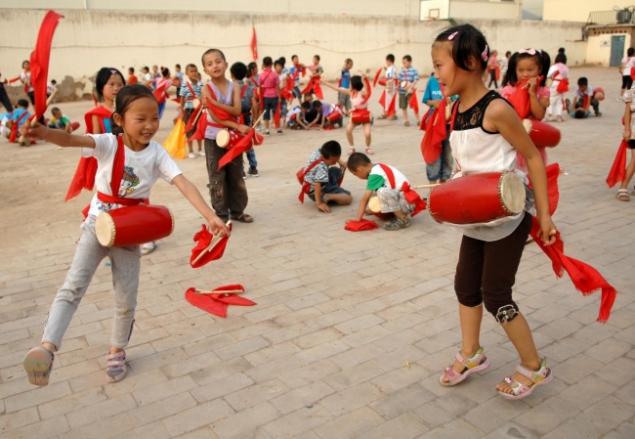
Change during lessons on the playing of the traditional drums, the city ANSI.
In class hanging a rating of student performance that stimulates learning better. Assessment ― from A to F, where A is the highest, corresponds to 90-100%, and F ― unsatisfactory 59%. Encouraging good behavior is an important part of the educational system. For example, for the correct answer or exemplary behavior in the classroom the student receives a star of a certain color or extra points. For conversations in the classroom or misconduct points and asterisks are removed. The students reflected on a special chart on the Board. Competition, so to speak, is obvious. Chinese children learn more than 10 hours every day. Lessons usually run from eight in the morning until three or four o'clock in the afternoon, after which children go home and do endless homework until nine or ten o'clock in the evening. On weekends schoolchildren from the big cities must undergo some additional classes with Tutors, they go to music school, art school and sports clubs. Due to high competition in the children from childhood is pressure from parents. If they will not be able to pass the exam after primary school (compulsory education in China is 12-13 years old), the way to University they ordered.
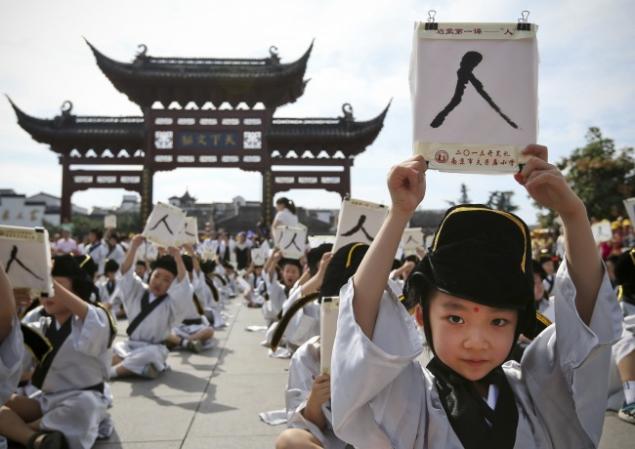
1 Sep first-graders "School of Confucius" in Nanjing take part in the ceremony of writing the character "Ren" ("people"), which begins with their training.
Schools are divided into public and private. The cost of education in private schools can reach up to thousands of dollars per month. The level of education is significantly higher. Particular importance is attached to learning a foreign language. Two or three lessons a day, and the fifth and sixth class pupils of elite schools already fluent in English. However, for example, in Shanghai there is a special government program, paid for by the government, under which foreign teachers teach at regular public schools. The education system based on rote memorization. The kids just memorize a huge amount of material. Teachers require auto-play, not particularly caring about how their learning is clear. But now increasingly popular alternative system of instruction: Montessori or Waldorf, aimed at the development of creative abilities in children. Of course, such schools are private, tuition is expensive and available to a very small number of people. Children from poor families, who do not want to learn or too naughty (according to parents), often taken from secondary schools and sent to school of kung fu. There they live in full Board, training from morning to evening and, if lucky, receive a basic primary education: they should be able to read and write, and, considering the system of the Chinese language is very difficult. In these schools, physical punishment is in order.


School of kung fu.
The teachers beat students with a stick-sword and, without further ADO, can make a leg or weigh a slap. But in the end the parents get disciplined young man with the profession of a trainer of kung fu and at least some chance to break through to people. Much of the known masters of kung fu took place a school of life. Quite widespread is also an option, where children with poor health give here for a year or two to ensure that they strengthened it, living and doing kung fu or tai Chi.

Regardless of where learn Chinese children ― school kung-fu or normal, from childhood they learn three main qualities: the ability to work, discipline and respect for elders by age and hierarchy.
They are taught from childhood that they must be the best, no matter what. Perhaps that is why now the Chinese are beginning to take the lead in all branches of science, culture and art. Competing with the Europeans, who grew up in more greenhouse conditions, they often do not leave them a chance. Just because we are not used to study for ten hours straight. Every day. All the year round.

Photo preview Lane Turner / the Boston Globe
Masha Pipenko specifically for the Website
See also
15 things I learned after living two years in China
As a PhD I have become a teacher of kung fu
via www.adme.ru/svoboda-puteshestviya/kak-ya-iz-kandidata-nauk-prevratilas-v-uchitelya-kun-fu-1263215/
Only one post on Facebook has changed the attendance at the restaurant of 0 to 500 people
13 dogs whose owners thought brought a fierce security guards. But I was mistaken


